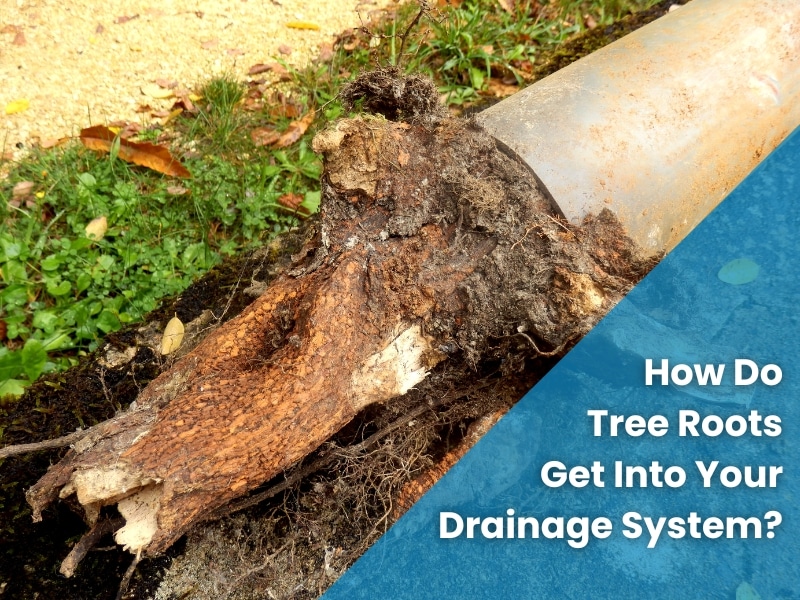Tree roots entering drainage pipes is a common problem for homeowners, particularly in cities like Sydney, where mature trees and established gardens are abundant. While trees offer shade, beauty, and environmental benefits, their roots can disrupt and damage plumbing systems. Understanding how tree roots infiltrate your pipes, identifying early signs, and knowing how to address and prevent the problem can save you from costly repairs.
What causes tree roots to invade drainage pipes?
Tree roots naturally seek out moisture and nutrients. When your drainage pipes experience even the most minor cracks or leaks, they release moisture and other organic materials that attract nearby tree roots.
Here are some common causes of root invasion in drainage pipes:
- Pipe damage: Small cracks or gaps in older pipes create weak points that attract roots.
- Condensation: Condensation on the outside of pipes can draw roots toward the pipes over time.
- Soil conditions: If the surrounding soil is dry, roots will seek out the water released from drainage pipes.
- Planting too close: Large trees planted near your home are more likely to cause root infiltration as the roots naturally spread outward to seek moisture.
- Pipe joints: Roots can squeeze into unsealed joints, where pipes are more vulnerable.
How can you identify tree roots in your drainage pipes early?
Early identification can save you from extensive repairs. Catching tree root invasion early means you can take immediate action to remove the roots and repair the damage. Here’s what to watch for:
- Slow-draining sinks and showers: This is often the first sign. If water drains slowly in multiple fixtures, tree roots could be a culprit.
- Frequent toilet blockages: Toilets that clog more often than usual may indicate root growth in pipes.
- Gurgling sounds: Unusual sounds coming from drains can signify a blockage.
- Unpleasant odours: Decaying organic matter stuck in pipes due to roots can release foul smells.
- Green patches in your yard: Lush patches or areas of fast-growing vegetation in your yard may indicate a leak beneath the surface that’s attracting roots.
Why are tree roots in drainage pipes a problem?
When tree roots enter drainage pipes, they can cause several severe plumbing issues. Addressing the problem before it escalates is critical.
Here are some ways that tree roots can impact your drainage system:
- Pipe blockages: Roots can fill pipes, preventing water from flowing and causing blockages.
- Pipe breakage: Tree roots exert pressure that can eventually cause the pipe to burst or collapse, leading to costly repairs.
- Sewage backups: In severe cases, sewage can back up into your home due to root intrusion, creating a health hazard.
- Water damage: Persistent leaks from root-damaged pipes can lead to water damage in your home or yard.
- Increased maintenance costs: Once roots enter pipes, regular maintenance may be needed to prevent recurring blockages.
What techniques are used to remove tree roots from drainage pipes?
Removing tree roots from drainage pipes requires professional tools and expertise. Plumbers use several standard techniques to clear the roots and restore water flow:
- Hydro jetting: High-pressure water jets break up roots and clear blockages. This method is effective and non-invasive.

- Mechanical augers: These rotating cutting tools can cut through roots and clear pipe interiors.
- Chemical root removal: Special chemicals can kill roots on contact without harming surrounding plants.
- Pipe relining: After removing roots, a plumber may suggest relining the pipes to seal any cracks and make them root-resistant.
- Video camera inspection: Before and after clearing the origins, a camera inspection is often performed to ensure all roots are removed and to check for pipe damage.
To maintain optimal plumbing performance and safety, it’s essential to follow local plumbing codes and standards. This ensures that root removal is done safely and effectively, complying with regulations to avoid future issues.
Can pipe relining help prevent tree roots from returning?
Pipe relining is a technique where a durable liner is inserted into the damaged pipe, creating a seamless, root-resistant barrier. This method is beneficial for properties prone to tree root invasion, as it seals off any cracks or weak points that might attract roots in the future.
The benefits of preventive pipe relining include:
- Root-resistant barrier: Relined pipes are smooth and durable, leaving no gaps for roots to penetrate.
- Minimal disruption: Pipe relining is a trenchless solution, meaning minimal disruption to your yard or landscaping.
- Long-lasting solution: A properly relined pipe can last for decades, reducing the need for constant maintenance.
- Cost-effective: Compared to replacing pipes, relining is often more affordable and quicker to complete.
- Environmentally friendly: Pipe relining doesn’t require excavation, which means less waste and impact on the environment.
How can you prevent tree roots from entering your drainage pipes again?
While pipe relining is an excellent long-term solution, there are other preventive measures to help protect your drainage system from root intrusion.
- Choose trees wisely: Strategic planting and regular maintenance can help reduce the risk of trees causing pipe damage by keeping roots away from your drainage system.
- Root barriers: Installing physical barriers in the soil can redirect roots away from pipes.
- Routine plumbing inspections: Regular inspections can help detect any developing issues early before they escalate.
- Keep soil moist: Keeping the surrounding soil moist can discourage roots from seeking water in your pipes.
- Repair cracks promptly: If a crack or leak is detected, prompt repair can prevent roots from entering.
When should you contact a professional for tree roots in drainage pipes?
If you suspect tree roots have invaded your drainage system, it’s best to consult a professional. Plumbers have specialised tools to identify and remove roots safely without causing further damage to your pipes. Here are signs that it’s time for blocked drain cleaning services:
- Persistent clogs: If you’ve attempted to clear a clog, but it keeps returning, tree roots could be the cause.
- Multiple blockages: Blockages in various drains across your home indicate a more significant issue in the main sewer line.
- Sewage odours: Foul smells in your home or yard suggest a break or blockage in the sewer line.
- Water backups: If water backs up in sinks or tubs, this is often a sign of a severe blockage in the drainage pipes.
- Visible root growth: If you can see roots growing around your drainage area, they may have entered the pipes.

Need help with blocked drains?
When dealing with tree root intrusion in your drainage pipes, rely on our expert team to handle it efficiently. Apex Plumbing Services, a trusted name in Sydney, offers a full range of plumbing services, including blocked drain plumbing, pipe relining, and leak detection. With over a decade of experience, we take pride in providing honest, affordable, and high-quality service.
If you suspect tree roots in your drainage system, don’t wait for the problem to escalate. Contact Apex Plumbing Services today for expert advice, a free quote, and prompt assistance. Let us help you keep your drains flowing smoothly and your home safe from plumbing issues.


